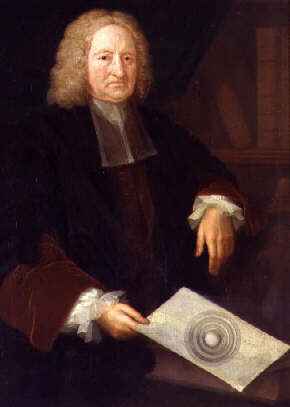Department
of
Science & Technology Studies
University College London
Nicholas Kollerstrom's
Newton's 1702 Lunar Theory
The Hollow Earth of Edmond Halley
Isaac Newton left an ultra-dense Moon circling the Earth.
To Edmond Halley, there was only one logical explanation: a hollow Earth.
It is sometimes claimed that Halley's prediction of a periodically-returning
comet, made in the autumn of 1895, was the first deduction drawn from the
new gravity theory of the Principia. Thus, 'Halley's prediction
of the comet's return was the first prediction based on Newton's theory
of gravitation' (Edmond Halley- A commemoration' QJRAS, 1993, 34,143).
This view is mistaken, as the first deduction to be drawn from the Principia
was in 1691, when Halley proposed to the Royal Society that the Earth was
hollow.
He drew this conclusion from the Principia's values
for lunar density:
'Sir Isaac Newton has demonstrated the
Moon to be more solid than our Earth, as 9 to 5; why may we not suppose
four ninths of our globe to be cavity?' (Phil Trans 1692 xvi 568)
 Implicit
in Halley's argument we may note is the notion of matter having uniform
density, whereby he reached his conclusion that four-ninths of Earth was
empty. Within this hollow Earth was another sphere, Halley explained, inhabited
and illuminated, which the force of gravity would keep from bumping into
the outer sphere. His bold hypothesis could also explain how the four
magnetic poles of the Earth were wandering about, by the slow rotation
of this inner sphere against the outer sphere.
Implicit
in Halley's argument we may note is the notion of matter having uniform
density, whereby he reached his conclusion that four-ninths of Earth was
empty. Within this hollow Earth was another sphere, Halley explained, inhabited
and illuminated, which the force of gravity would keep from bumping into
the outer sphere. His bold hypothesis could also explain how the four
magnetic poles of the Earth were wandering about, by the slow rotation
of this inner sphere against the outer sphere.
'The concave arches may
in several places shine with such a substance as invests the surface of
the Sun,'
Halley rhapsodically explained, of this under-world. He added,
in words for which science-fiction writers of futurity would be grateful:
'I have adventured to make
these Subterranean orbs capable of being inhabited.'
It was, he found, unthinkable that all the matter of the
Earth should exist 'barely to support its surface.' Rather, 'Almightly
Wisdom' had designed a fully inhabited universe: as all the planets were
doubtless inhabited, so likewise were the spheres below. Conceding that
he was using a teleological argument, though Bacon had warned that one
should be careful of such, he proposed that the Earth's matter had been
distributed 'to yield as great a surface for use of living Creatures as
can consist with the conveniency and security of the whole.' As an aside,
some might see a problem with earthquakes, he conceded, as tending to flood
the nether regions by the oceans leaking through cracks in the outer shell;
however, the Earth has "petrifying particles," Halley explained, as would
soon damn up any such leaks.
In 1716 a magnificent aurora borealis was visible
over much of northern Europe (signifying the conclusion of the 'Maunder
Minimum', a period when a dormant Sun was virtually devoid of sunspots,
for over sixty years, believed to correspond to a mini-ice-age in the late
seventeenth century when the Thames froze solid). The Royal Society required
Halley's opinion, and he gave an explanation in terms of the non-spherical
shape of the Earth, as described in the Principia. There was an
illuminated vapour inside the hollow Earth which would occasionally 'transude
through and penetrate the Cortex of the Earth.' This vapour tended to emerge
from the polar regions, as the crust was thinner there.
Halley's essay on the subject was popular and frequently
reprinted. In 1717 a theological treatise by William Whiston (Astronomical
Principles of Religion) incorportated Halley's arguments, differing
only in that it found scriptural corroboration, as Halley had not, for
the lower regions of the hollow Earth being inhabited. When, in later years,
Halley had his portrait painted as the Astronomer Royal in 1736, he had
himself depicted with a diagram showing the multiple shells of his hollow
Earth.
Sources: Kollerstrom, 1985, 1991,1992
(NB, The above material is not contained in my Doctoral thesis).
The contents of this page remain
the copyrighted, intellectual property of Nicholas Kollerstrom. Details.
rev: May 1998
 Implicit
in Halley's argument we may note is the notion of matter having uniform
density, whereby he reached his conclusion that four-ninths of Earth was
empty. Within this hollow Earth was another sphere, Halley explained, inhabited
and illuminated, which the force of gravity would keep from bumping into
the outer sphere. His bold hypothesis could also explain how the four
magnetic poles of the Earth were wandering about, by the slow rotation
of this inner sphere against the outer sphere.
Implicit
in Halley's argument we may note is the notion of matter having uniform
density, whereby he reached his conclusion that four-ninths of Earth was
empty. Within this hollow Earth was another sphere, Halley explained, inhabited
and illuminated, which the force of gravity would keep from bumping into
the outer sphere. His bold hypothesis could also explain how the four
magnetic poles of the Earth were wandering about, by the slow rotation
of this inner sphere against the outer sphere.